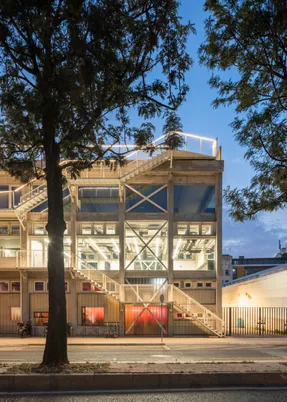Factory Lisbon
JULIAN BREINERSDORFER ARCHITEKTEN TEAM
Lena Brandt, Alessandro Cugola, Corinna Studier, Gareth Hammond
ELECTRICAL INSTALLATIONS
Iberinstal
ACOUSTIC CONSULTANT
Inside Building
LIGHTING CONSULTANTS
Lledo, Ohm Light Design
DESIGN ARCHITECT
Julian Breinersdorfer Architekten
HVAC
Engavac
PERMIT ARCHITECT
José Baganha Arquitectos
PERMIT ARCHITECT TEAM
Raquel Coutinho, Carolina Costa
PROJECT ARCHITECT
Angela Maurice Arquitectos
PROJECT ARCHITECT TEAM
Goncalo Soares
FIRE ENGINEERS
Antonio Matias, Daniel Arena
CONCEPT DIRECTION
Simon Schaefer
ARTWORK AND SIGNAGE
Constantin Peyfuss
PARTITIONS
Line Systems
`FACADE CONTRACTOR
F&j Lotra
TEAM
Carlota Pires De Almeida, Jeremy Bamberg
CONSTRUCTION MANAGER
Pedro Reis
SUPERVISION
Afaplan
TECHNICAL COORDINATOR
Alberto Cabral
STRUCTURAL ENGINEERS
Ricardo Sampaio, Duarte Silveira
PHOTOGRAPHS
Francisco Nogueira, Guillaume Bonn, Julian Breinersdorfer
WOOD PANELLING
Mbf
AREA
12400 M²
YEAR
2022
LOCATION
Lisbon, Portugal
CATEGORY
Workshop, Adaptive Reuse
Factory Lisbon is the adaptive reuse of a 1973 cookie and noodle factory of the Portuguese military.
The heritage-protected building sits on Lisbon‘s harbor front, in a historic army supply complex, currently being transformed into an innovation district, Hub Criativo de Beato. Shaped to house noodle machines, the building is 200m long and only 11m wide.
This slender volume would normally require the introduction of several concrete cores for emergency circulation.
In order to avoid such a disruptive intervention, all circulation has been attached externally.
In the shape of lightweight steel walkways and single-flight stairs, it meanders along the façades and weaves around the historic silos and an elevator shaft in the center of the building.
Here, the stairs are suspended from the ceiling, to minimize their structural impact. The new elevator shaft is clad with mirrors, so it blends with the historic colors and features.
The ribbon-shaped circulation ties together Factory‘s unique blend of program and design principles: office spaces for large companies and start-ups are combined with event spaces, local restaurants, and a 2.000m2 public access roof terrace.
The design approach is to retain old materials and surfaces wherever possible and contrast them with contemporary elements of concrete, steel, glass, and wood.
Factory Lisbon aims to make a multilayered and nuanced impact on Beato‘s local community.
There is a strong focus on making the venue accessible to a diverse local and international public, beyond that of the typical conference business: current events cover tech, food, gender, skateboarding, fashion, architecture, and art, on both a for- and non-profit basis.
Architecture and concept have been developed in an interdisciplinary and collaborative effort.
Aligning bold architecture respectfully along its given context is the shared Leitmotiv of Factory‘s founder Simon Schaefer, and the architects Julian Breinersdorfer, José Baganha, and Angela Maurice.
In line with these design principles, all major interventions are drawn as white steel lines.
They add or fix what is necessary while leaving the historic building body legible and intact. In addition to the walkways, St.
Andreas crosses have been attached to make the building earthquake resistant, brick façade elements have been opened as white-framed glazing, to bring light in or allow for circulation, and mezzanine floors have been extended to use high spaces more efficiently.
The necessary technical installations are treated as veins, unashamedly taking their place in the building's body.
They are visible as technological transformations, adapting the functionality of an old food production facility to contemporary office and event uses.
Plants and wooden buildout elements bring a nonindustrial softness, without leaving the 1970s palette.
Historic details like two cookie machines, the yellow perforated brick walls, and damaged marble staircases have been lovingly restored and integrated.
All building materials, finishes, and geometries have been selected to vibrate with Lisbon‘s magic Atlantic light.





































